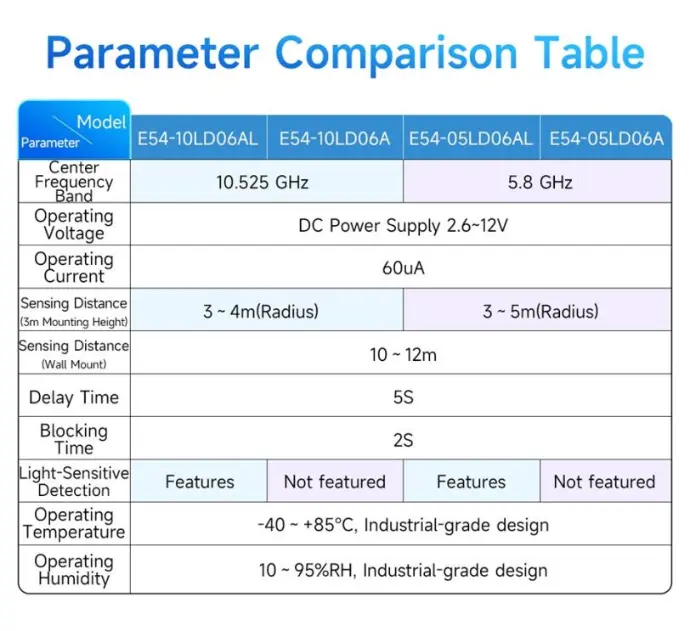With the increasing popularity of smart devices, millimeter-wave radar and infrared, two mainstream sensor technologies, are reshaping how humans perceive the environment in different ways. From automotive ADAS systems to smart home security, industrial testing to medical imaging, the two technologies exhibit significant differences in their principles, functional characteristics, and applicable scenarios. This article will combine technical details with practical examples to analyze the core differences and application boundaries of these two sensing technologies.
- Principle Comparison: Electromagnetic Waves and Thermal Radiation
1. Millimeter-Wave Radar: A Precise Electromagnetic Detector
Millimeter-wave radar detects targets by emitting electromagnetic waves with a wavelength of 110 mm (30-300 GHz). Its core principle is based on frequency-modulated continuous wave (FMCW) technology. Radar transmits a signal with a frequency that varies linearly over time. When it encounters a target, an echo is reflected. The frequency difference between the echo and the transmitted wave is analyzed to calculate distance, and velocity information is obtained by combining the Doppler effect.
Typical workflow:
Transmits a conical electromagnetic beam (rather than a straight beam like lidar).
Receives multipath reflected signals via a MIMO antenna array.
Uses phase differences to calculate the target's azimuth and elevation angles.
2. Infrared: Recording Thermal Radiation
Infrared sensors detect infrared radiation (wavelength 0.781000μm) emitted by target objects. Their operating principles fall into two categories:
Photon detectors: Convert infrared radiation into electrical signals based on the photoelectric effect (e.g., mercury cadmium telluride).
Heat detectors: Use heat-sensitive materials to detect the temperature rise caused by radiation (e.g., thermopile sensors).
Typical applications include thermal imagers in security surveillance systems, which capture the 814μm far-infrared radiation emitted by humans to achieve night vision.
- Functional characteristics: penetration and temperature sensitivity
Features |
Millimeter-wave radar |
|
Penetration capability |
Can penetrate rain, fog, smoke, and dust (non-metallic materials) |
Cannot penetrate solid obstacles |
Environmental adaptability |
Operates in all weather conditions (not affected by light or temperature) |
Susceptible to interference from ambient temperature and light |
Detection dimensions |
Measures distance, speed, and angle (4D radar also includes altitude) |
Only provides temperature distribution and target outline |
Resolution |
Low angular resolution (conventional 3D radar is approximately 1°) |
Spatial resolution can reach centimeters (thermal imager) |
Data output |
Velocity vector information for dynamic targets |
Static thermal radiation distribution map |
Typical Examples:
In heavy rain, millimeter-wave radar can still reliably detect vehicles up to 200 meters away (through raindrops), while infrared sensors may experience false alarms due to scattering from raindrops.
Smart air conditioners use infrared light to detect human positions for precise air delivery, but these cannot penetrate glass curtain walls. Millimeter-wave radar, on the other hand, can penetrate non-metallic walls and detect the presence of people indoors.
III. Core Differences: Physical Properties and Applicability
1. Essential Differences in Physical Mechanisms
Millimeter-wave radar: Relies on the reflection and phase changes of electromagnetic waves and is an active detection method (requires signal transmission).
Infrared: Based on the target's own thermal radiation or reflected infrared light, it is a passive/semi-active detection method (some require an infrared light source).
2. Different Environmental Adaptability
Millimeter-wave radar demonstrates advantages in the following scenarios: inclement weather (dense fog/blizzard), strong light interference, etc.
The unique value of infrared sensors: For example, fire warning and non-contact temperature measurement
3. Cost and Integration Complexity
Millimeter-wave radar: A 24GHz module costs approximately $50,100, while a high-end 77GHz solution exceeds $300 and requires complex signal processing algorithms.
Infrared sensors: A basic thermopile element costs only $520, but a high-resolution thermal imager can cost over $1,000.
Ⅳ.Related product recommendations
The E54 series is an outstanding life presence sensing sensor reference design within Ebyte's millimeter-wave radar portfolio. It integrates efficient 24GHz millimeter-wave sensor hardware with the intelligent algorithm firmware HPS01. The sensor hardware comprises an AIoT millimeter-wave sensor chip, a high-performance transmit-receive microstrip antenna, an MCU, and supporting peripheral circuits. The intelligent algorithm firmware HPS01 utilizes the FMCW waveform and proprietary advanced signal processing technology. This solution is primarily designed for indoor environments such as homes, offices, and hotels, enabling accurate human presence sensing.

Ⅴ.Conclusion
Millimeter-wave radar and infrared are like twins in the perception world—the former excels at dynamic target tracking and all-weather operation, while the latter excels at temperature sensing and high-resolution imaging. In scenarios like intelligent driving, industrial inspection, and security monitoring, the two technologies are far more complementary than competitive. With the advancement of chip computing power and multi-sensor fusion algorithms, we will see more hybrid "millimeter wave + infrared" sensing solutions in the future, building a more reliable environmental perception system for humans.